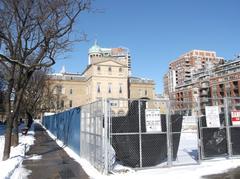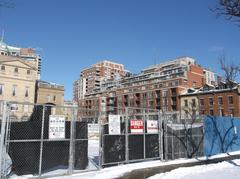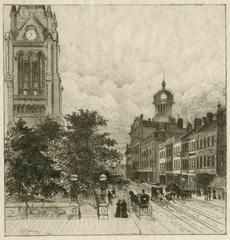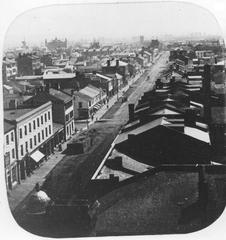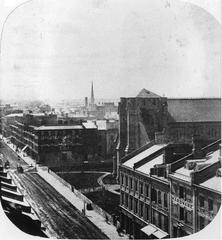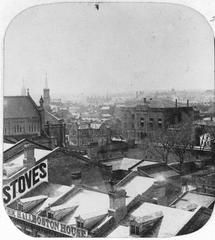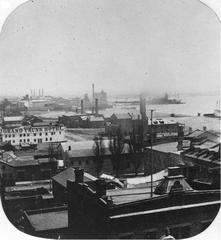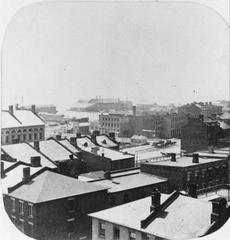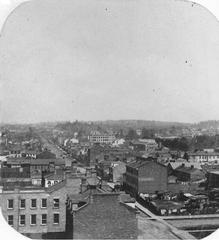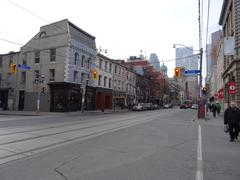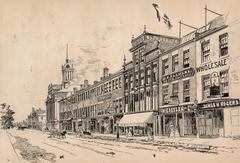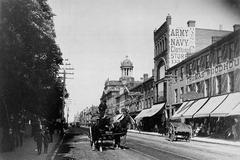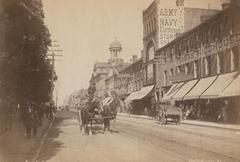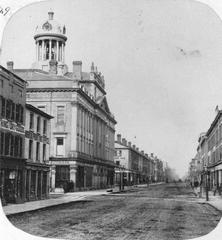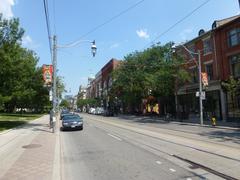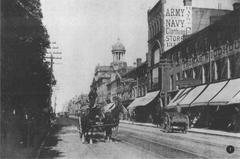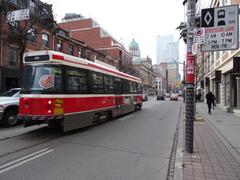
St. Lawrence Hall Toronto: Visiting Hours, Tickets, and Historical Guide
Date: 15/06/2025
Introduction
St. Lawrence Hall, nestled in Toronto’s historic Old Town, is a celebrated architectural and cultural landmark. Completed in 1850, this Renaissance Revival masterpiece was conceived as a resilient civic center after the Great Fire of 1849, symbolizing Toronto’s rebirth and aspirations (Heritage Toronto; Parks Canada). Known for its stately façade, Corinthian pilasters, and grand cupola, the Hall has been a hub for public assemblies, abolitionist meetings, and cultural events for generations. Today, it remains a dynamic venue integrated with the vibrant St. Lawrence Market district, drawing visitors eager to experience Toronto’s 19th-century heritage (Taylor on History; BlogTO; St. Lawrence Market).
This guide details St. Lawrence Hall’s history, architecture, visiting hours, ticketing, accessibility, nearby attractions, and tips to ensure a memorable visit.
Contents
- Historical Overview
- Origins and Construction
- Architectural Features
- Social and Cultural Legacy
- Abolitionist Movement Role
- Decline and Restoration
- Modern Use
- Visitor Information
- Visiting Hours
- Tickets and Admission
- Accessibility
- Getting There
- Architectural Highlights
- Exterior Design
- Interior Spaces
- Materials and Restoration
- Influences and Adaptive Use
- Nearby Attractions
- Frequently Asked Questions (FAQ)
- Conclusion and Visitor Tips
- References
Historical Overview
Origins and Construction
St. Lawrence Hall was commissioned by the City of Toronto in 1850, designed by William Thomas in the Renaissance Revival style. Built after the 1849 fire, it was named for St. Lawrence, Canada’s patron saint, and strategically placed at King and Jarvis Streets, adjacent to the bustling St. Lawrence Market (Heritage Toronto; Parks Canada).
Architectural Features
The Hall’s symmetrical façade features three grand archways, Corinthian pilasters, and a distinctive cupola that originally housed clocks facing all directions. Its French Mansard roof was both an aesthetic and functional choice to withstand Toronto’s winters. The building’s structure comprises four stories, with the ground floor for shops, the second for offices, and the third for a large assembly room (Taylor on History; BlogTO).
Social and Cultural Legacy
From 1850 onward, St. Lawrence Hall was Toronto’s premier venue for public assemblies, lectures, concerts, and balls. Its Grand Ballroom, with a capacity of 1,000, hosted prominent figures such as Sir John A. Macdonald, George Brown, and Thomas D’Arcy McGee (The Canadian Encyclopedia).
Abolitionist Movement Role
The Hall was a significant site for abolitionist gatherings, supporting the fight against slavery and serving as a beacon for refugees of the Underground Railroad (Parks Canada). This advocacy cemented its place in Canadian social justice history.
Decline and Restoration
By the early 20th century, the Hall’s prominence waned as Toronto grew westward. The building fell into disrepair until a major restoration in 1967, part of Canada’s Centennial, returned it to its former glory and earned it designation as a National Historic Site (Heritage Toronto; Parks Canada).
Modern Use
Today, St. Lawrence Hall is a venue for weddings, concerts, art shows, and community events. Its Grand Ballroom and meeting rooms are sought-after rental spaces, maintaining the Hall as a living part of Toronto’s civic life (BlogTO).
Visitor Information
Visiting Hours
- General Access: The Hall is open to the public during special events, heritage tours, and by appointment. The Grand Ballroom is primarily accessible during scheduled events like Doors Open Toronto.
- Business Hours: Ground floor commercial spaces are open during regular business hours; interior access varies.
- Check ahead: For current hours and event schedules, consult the St. Lawrence Market website, City of Toronto, or Heritage Toronto.
Tickets and Admission
- General Admission: Free during public events and tours.
- Special Events: Some private events or guided tours may require tickets; prices vary per event.
- Reservations: Usually not required for general visiting; recommended for tours and special programs.
Accessibility
- Fully wheelchair accessible, with elevators, ramps, and accessible washrooms.
- Visitors with specific needs should contact the Hall in advance for assistance.
Getting There
- Address: 157 King Street East, Toronto, ON
- Transit: Easily reached via TTC streetcars and buses at King and Jarvis.
- Parking: Available at the St. Lawrence Market and nearby lots.
- Travel Tip: Use public transit during peak hours and check for event-related street closures.
Architectural Highlights
Exterior Design
St. Lawrence Hall is a quintessential example of Victorian classicism and Renaissance Revival architecture. Its King Street East façade boasts three grand arches, Corinthian pilasters, the city’s coat of arms, and a striking cupola (Taylor on History). The French Mansard roof is both decorative and practical, shedding snow efficiently.
Interior Spaces
The third-floor Grand Ballroom is the Hall’s showpiece, featuring an ornate plaster ceiling, a massive crystal chandelier, and a gallery for enhanced acoustics. Originally seating up to 1,000, the Grand Hall hosted balls, concerts, and political gatherings (Taylor on History; Archiseek).
Materials and Restoration
Constructed with local stone and robust timber, the Hall was designed for fire resistance and longevity—a lesson learned from the 1849 fire. The 1967 restoration meticulously rebuilt the collapsed east wall and preserved period architectural details throughout (Taylor on History).
Influences and Adaptive Use
Architect William Thomas drew on Italian Renaissance and French design, blending classical symmetry with practical innovations for the Canadian climate. Over time, the Hall adapted to host modern events, remaining a versatile civic space (Taylor on History; Archiseek).
Nearby Attractions
- St. Lawrence Market: Adjacent to the Hall, this market is world-renowned for its food vendors and vibrant atmosphere (St. Lawrence Market).
- Distillery Historic District: A pedestrian-only area with Victorian-era industrial architecture, shops, and galleries.
- Flatiron Building & Hockey Hall of Fame: Both within walking distance, offering more of Toronto’s historic and cultural charm.
- Sunday Antique Market: Located nearby, perfect for collectors and vintage enthusiasts (Toronto For You).
Frequently Asked Questions (FAQ)
Q: What are the regular visiting hours for St. Lawrence Hall?
A: Public access is primarily during special events and heritage tours. Ground floor businesses have regular hours; check the official site for current details.
Q: Do I need tickets to visit?
A: General admission is free. Special events or tours may require tickets.
Q: Is St. Lawrence Hall accessible?
A: Yes, the Hall is fully accessible with elevators, ramps, and accessible washrooms.
Q: Are guided tours available?
A: Yes, during special events like Doors Open Toronto and through organizations such as Heritage Toronto.
Q: What is the nearest transit stop?
A: King and Jarvis Streets, serviced by TTC streetcars and buses. King subway station is a short walk away.
Conclusion and Visitor Tips
St. Lawrence Hall stands as a living testament to Toronto’s architectural grandeur and social history. From its origins as a symbol of civic pride and resilience to its ongoing role in the city’s cultural life, the Hall is a must-see for visitors and locals alike. Pair your visit with the St. Lawrence Market for a full day of exploration, and check schedules for special events or tours to appreciate the Hall’s interiors.
Visitor Tips:
- Consult official resources for current visiting hours and event schedules.
- Use public transit for convenience.
- Bring a camera—the architecture is photogenic inside and out.
- Download the Audiala app for audio tours and insider historical insights.
References
- Heritage Toronto – St. Lawrence Hall
- Parks Canada – St. Lawrence Hall
- BlogTO – St. Lawrence Hall
- Taylor on History – Enjoying Toronto’s Architectural Gems: The St. Lawrence Hall (2012)
- The Canadian Encyclopedia – St. Lawrence Hall
- The Globe and Mail – Rebuilding the Heartbeat of Old Toronto (2023)
- Toronto Journey 416 – St. Lawrence Hall
- St. Lawrence Market Official Site
- Destination Toronto – St. Lawrence Market Complex
- Destination Ontario – The Locals’ Guide: The St. Lawrence Market
- TripSavvy – Toronto St. Lawrence Market Guide
- Historical Marker Database – St. Lawrence Hall
- Canadian Train Vacations – Best Things to Do in Toronto (2023)
- Toronto For You – St. Lawrence Sunday Antique Market
- Archiseek – St. Lawrence Hall
